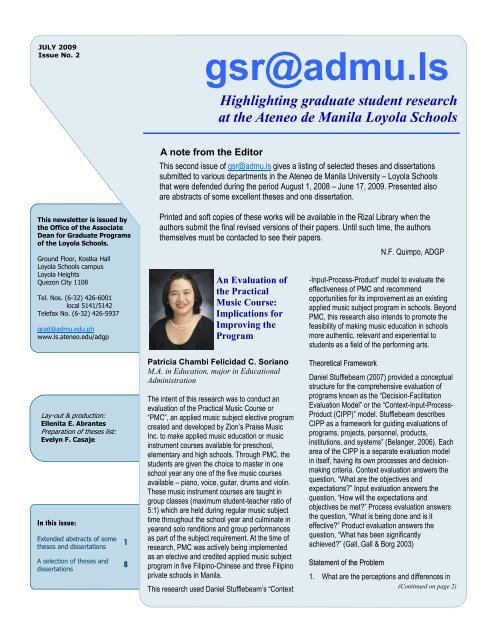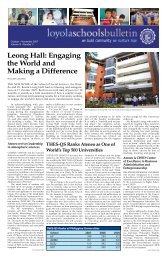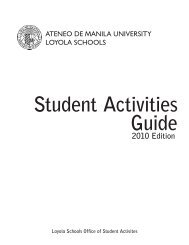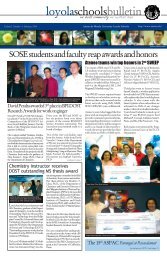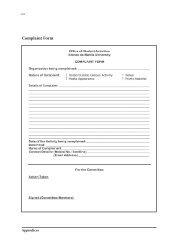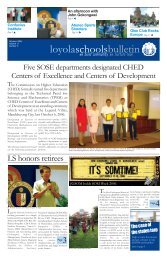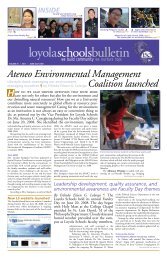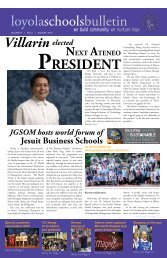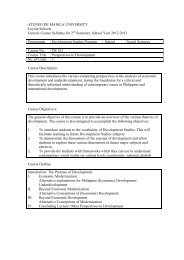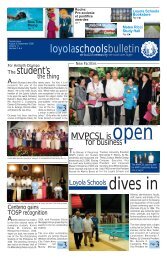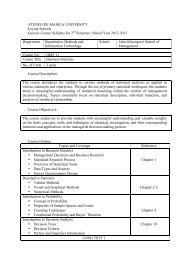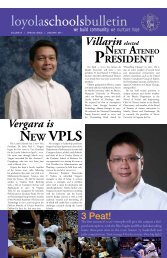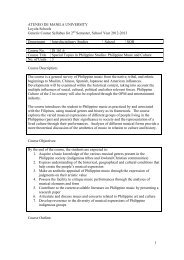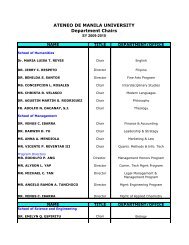gsr@admu.ls - Ateneo de Manila University
gsr@admu.ls - Ateneo de Manila University
gsr@admu.ls - Ateneo de Manila University
Create successful ePaper yourself
Turn your PDF publications into a flip-book with our unique Google optimized e-Paper software.
JULY 2009<br />
Issue No. 2<br />
This newsletter is issued by<br />
the Office of the Associate<br />
Dean for Graduate Programs<br />
of the Loyola Schoo<strong>ls</strong>.<br />
Ground Floor, Kostka Hall<br />
Loyola Schoo<strong>ls</strong> campus<br />
Loyola Heights<br />
Quezon City 1108<br />
Tel. Nos. (6-32) 426-6001<br />
local 5141/5142<br />
Telefax No. (6-32) 426-5937<br />
grad@admu.edu.ph<br />
www.<strong>ls</strong>.ateneo.edu/adgp<br />
Lay-out & production:<br />
Ellenita E. Abrantes<br />
Preparation of theses list:<br />
Evelyn F. Casaje<br />
In this issue:<br />
Exten<strong>de</strong>d abstracts of some<br />
theses and dissertations<br />
A selection of theses and<br />
dissertations<br />
1<br />
8<br />
<strong>gsr@admu</strong>.<strong>ls</strong><br />
A note from the Editor<br />
Highlighting graduate stu<strong>de</strong>nt research<br />
at the <strong>Ateneo</strong> <strong>de</strong> <strong>Manila</strong> Loyola Schoo<strong>ls</strong><br />
This second issue of <strong>gsr@admu</strong>.<strong>ls</strong> gives a listing of selected theses and dissertations<br />
submitted to various <strong>de</strong>partments in the <strong>Ateneo</strong> <strong>de</strong> <strong>Manila</strong> <strong>University</strong> – Loyola Schoo<strong>ls</strong><br />
that were <strong>de</strong>fen<strong>de</strong>d during the period August 1, 2008 – June 17, 2009. Presented a<strong>ls</strong>o<br />
are abstracts of some excellent theses and one dissertation.<br />
Printed and soft copies of these works will be available in the Rizal Library when the<br />
authors submit the final revised versions of their papers. Until such time, the authors<br />
themselves must be contacted to see their papers.<br />
An Evaluation of<br />
the Practical<br />
Music Course:<br />
Implications for<br />
Improving the<br />
Program<br />
Patricia Chambi Felicidad C. Soriano<br />
M.A. in Education, major in Educational<br />
Administration<br />
The intent of this research was to conduct an<br />
evaluation of the Practical Music Course or<br />
“PMC”, an applied music subject elective program<br />
created and <strong>de</strong>veloped by Zion’s Praise Music<br />
Inc. to make applied music education or music<br />
instrument courses available for preschool,<br />
elementary and high schoo<strong>ls</strong>. Through PMC, the<br />
stu<strong>de</strong>nts are given the choice to master in one<br />
school year any one of the five music courses<br />
available – piano, voice, guitar, drums and violin.<br />
These music instrument courses are taught in<br />
group classes (maximum stu<strong>de</strong>nt-teacher ratio of<br />
5:1) which are held during regular music subject<br />
time throughout the school year and culminate in<br />
yearend solo renditions and group performances<br />
as part of the subject requirement. At the time of<br />
research, PMC was actively being implemented<br />
as an elective and credited applied music subject<br />
program in five Filipino-Chinese and three Filipino<br />
private schoo<strong>ls</strong> in <strong>Manila</strong>.<br />
This research used Daniel Stufflebeam’s “Context<br />
-Input-Process-Product” mo<strong>de</strong>l to evaluate the<br />
effectiveness of PMC and recommend<br />
opportunities for its improvement as an existing<br />
applied music subject program in schoo<strong>ls</strong>. Beyond<br />
PMC, this research a<strong>ls</strong>o intends to promote the<br />
feasibility of making music education in schoo<strong>ls</strong><br />
more authentic, relevant and experiential to<br />
stu<strong>de</strong>nts as a field of the performing arts.<br />
Theoretical Framework<br />
Daniel Stufflebeam (2007) provi<strong>de</strong>d a conceptual<br />
structure for the comprehensive evaluation of<br />
programs known as the “Decision-Facilitation<br />
Evaluation Mo<strong>de</strong>l” or the “Context-Input-Process-<br />
Product (CIPP)” mo<strong>de</strong>l. Stufflebeam <strong>de</strong>scribes<br />
CIPP as a framework for guiding evaluations of<br />
programs, projects, personnel, products,<br />
institutions, and systems” (Belanger, 2006). Each<br />
area of the CIPP is a separate evaluation mo<strong>de</strong>l<br />
in itself, having its own processes and <strong>de</strong>cisionmaking<br />
criteria. Context evaluation answers the<br />
question, “What are the objectives and<br />
expectations?” Input evaluation answers the<br />
question, “How will the expectations and<br />
objectives be met?” Process evaluation answers<br />
the question, “What is being done and is it<br />
effective?” Product evaluation answers the<br />
question, “What has been significantly<br />
achieved?” (Gall, Gall & Borg 2003)<br />
Statement of the Problem<br />
N.F. Quimpo, ADGP<br />
1. What are the perceptions and differences in<br />
(Continued on page 2)
2 <strong>gsr@admu</strong>.<strong>ls</strong><br />
(Continued from page 1)<br />
the perceptions of the stu<strong>de</strong>nts, teachers,<br />
parents and school administrators on the<br />
Context, Input, Process and Product<br />
Components of the Practical Music Course?<br />
2. What implications can be drawn from the<br />
findings to improve the Practical Music<br />
Course program?<br />
Method<br />
From the three longest-running PMC schoo<strong>ls</strong><br />
(International Christian Aca<strong>de</strong>my, MGC New Life<br />
Christian Aca<strong>de</strong>my, Makati Hope Christian<br />
School), two hundred (200) middle school and<br />
high school stu<strong>de</strong>nts, two hundred (200) parents<br />
of a different set of middle school and high school<br />
stu<strong>de</strong>nts, (30) thirty PMC teachers and seventeen<br />
(17) school administrators were selected as<br />
research subjects to answer the “AMPEQ” or<br />
“Applied Music Subject Program Evaluation<br />
Questionnaire”.<br />
AMPEQ is a four-part rating questionnaire<br />
constructed by the researcher to evaluate PMC<br />
based on the four components of the CIPP mo<strong>de</strong>l.<br />
Each of the four parts of AMPEQ is composed of<br />
fifteen statements that are to be rated using a five<br />
-point scale. Two open-en<strong>de</strong>d questions were<br />
inclu<strong>de</strong>d at the end of each questionnaire.<br />
The AMPEQ was prepared in four versions:<br />
AMPEQ for PMC Stu<strong>de</strong>nts, AMPEQ for PMC<br />
Parents, AMPEQ for PMC Teachers, and AMPEQ<br />
for School Administrators.<br />
Results<br />
The stu<strong>de</strong>nts, parents, teachers and school<br />
administrators perceived that the context, input,<br />
process and product components of the Practical<br />
Music Course are functioning effectively. Findings<br />
of the study a<strong>ls</strong>o show that the perceptions of the<br />
research subjects in all the CIPP components of<br />
PMC are the same.<br />
Implications for Improvement<br />
The study revealed opportunities for further<br />
improvement of the Practical Music Course by<br />
− increasing the stu<strong>de</strong>nt’s present level of<br />
confi<strong>de</strong>nce in public performance and selfexpression,<br />
Following are the i<strong>de</strong>ntified CIPP components for the Practical Music Course:<br />
CONTEXT<br />
What are the objectives<br />
or expectations?<br />
INPUT<br />
How will the expectations<br />
or objectives be met?<br />
PROCESS<br />
What is being done and<br />
is it effective?<br />
PRODUCT<br />
What has been significantly<br />
achieved?<br />
CIPP COMPONENTS OF PMC<br />
ITEMS FOR EVALUATION<br />
Needs<br />
Assets<br />
Problems<br />
Teaching Facilities & Equipment<br />
Teachers & Instructional Strategies<br />
Curriculum & Class Format<br />
Performance Exposure<br />
Stu<strong>de</strong>nt Practice<br />
Parental Support<br />
Teacher Processes<br />
Stu<strong>de</strong>nt Processes<br />
Impact<br />
Effectiveness<br />
Sustainability<br />
Transportability
JULY 2009<br />
− providing more avenues for sharing their<br />
musical skil<strong>ls</strong> with other people,<br />
− establishing better parent-teacher<br />
communication, and<br />
− encouraging stronger parental support and<br />
consistent practice at home.<br />
E-mail add: pcfsoriano@yahoo.com<br />
On the Complexities of the Block<br />
Sorting and Poset Cover Problems<br />
Proceso L. Fernan<strong>de</strong>z, Jr.<br />
Ph.D. in Computer Science<br />
A permutation of length n is an or<strong>de</strong>red<br />
arrangement of n elements. It is normal to<br />
consi<strong>de</strong>r the set [n] = {1, 2, …, n} when<br />
constructing a permutation. Such a constructed<br />
permutation belongs to the symmetric group Sn ,<br />
the set of all permutations of [n].<br />
As an or<strong>de</strong>red arrangement, a permutation can be<br />
used to represent an or<strong>de</strong>r-related structure. This<br />
can be a sequence of events, a string of images<br />
or even something as simple as an array of<br />
numbers. Using a generic representation allows a<br />
solution to one problem to become applicable to a<br />
multitu<strong>de</strong> of other problems.<br />
In this dissertation, two difficult problems whose<br />
inputs involve permutations are explored. The first<br />
problem is the Block Sorting problem. The input is<br />
a permutation π ∈ Sn , and the output is the<br />
minimum number of block moves required to sort<br />
π. A block within a permutation is <strong>de</strong>fined as a<br />
maximal sequence of (increasing) consecutive<br />
integers. A block move relocates a single block<br />
within the permutation to produce a longer block.<br />
Figure 1 shows two different sequences of block<br />
moves that can sort the input permutation. The<br />
shortest possible such sequence gives a solution<br />
to the Block Sorting problem for the given<br />
permutation.<br />
Figure 1: Two sequences of block moves that can sort<br />
the permutation π = 7 3 4 5 1 2 6 8<br />
This problem has been proven to be NP-<br />
Complete, and is therefore as difficult as, say, the<br />
famous Travelling Salesman Problem. No better<br />
than 2-approximations have been found for this<br />
problem. Roughly, this means that the current<br />
best heuristics can only guarantee that the output<br />
will never be worse than twice the optimal result.<br />
Applications of the Block Sorting problem can be<br />
found in Optical Character Recognition (OCR) as<br />
a metric for quantifying the quality of OCR<br />
procedures and in computational biology,<br />
particularly in the study of genome<br />
rearrangements.<br />
In this study, the following significant theoretical<br />
results were obtained:<br />
1. It was shown that, for a random permutation,<br />
any algorithm will (with high probability) not<br />
produce a result worse than twice the<br />
optimal<br />
2. It was proven that the 2-approximation ratio<br />
of Bein’s Abs-Block Deletion algorithm is<br />
tight.<br />
3. The theoretical lower bound for the size of<br />
the smallest block sorting sequence was<br />
improved.<br />
4. New optimal moves and the first (proved)<br />
sub-optimal moves were found.<br />
Some empirical results were a<strong>ls</strong>o gathered for the<br />
P. L. Fernan<strong>de</strong>z, Jr.<br />
3
4 <strong>gsr@admu</strong>.<strong>ls</strong><br />
J. P. Lota<br />
“… there is a need to<br />
… remove redundancy<br />
in the PhilRice<br />
genebank.” BINANGKURO<br />
Block Sorting problem. Most notable among these<br />
is the creation of 3 heuristics that (empirically)<br />
produce better results than the current best<br />
approximation algorithms.<br />
The second problem is the Poset Cover problem.<br />
The input is a set of permutations over the same<br />
set of elements, and the goal is to find a minimum<br />
set of partial or<strong>de</strong>r sets (posets) that characterizes<br />
the entire input set (see Fig. 2).<br />
Figure 2: A Poset Cover instance and solution<br />
The Poset Cover problem finds its application in<br />
computational neuroscience, systems biology,<br />
paleontology and physical plant engineering. This<br />
problem has a<strong>ls</strong>o been shown to be NP-Complete<br />
and no heuristic with theoretical approximate<br />
bounds has yet been published for this problem.<br />
Three of several main results in this dissertation<br />
for the Poset Cover problem are the following:<br />
1. The Poset Cover problem is shown to be<br />
NP-complete even when restricted to<br />
hammock(2,2,2)-posets. This is remarkable<br />
consi<strong>de</strong>ring that this class is very<br />
constrained already and that, for<br />
the slightly more constrained class<br />
of kite(2)-posets, the problem has<br />
been shown to have a polynomialtime<br />
solution.<br />
2. Exact algorithms are presented for<br />
solving the Poset Cover problem<br />
that assumes a single poset<br />
solution. The general case (i.e., no<br />
poset class restriction) runs in an<br />
improved polynomial time of O<br />
(mn+n 3), while for 2 specific poset<br />
classes -- tree posets and levelled<br />
posets -- the run time is further<br />
improved to O(mn+n 2).<br />
3. Two data structures are formulated<br />
for more compactly representing<br />
the input set of permutations and for<br />
improving the running time of some<br />
algorithms.<br />
At the end of the dissertation, a good number of<br />
recommendations were presented based on the<br />
results gathered in this study.<br />
Analysis of Genetic Diversity and<br />
Redundancy in Rice Germplasm<br />
Collection by DNA Fingerprinting<br />
Jamaica P. Lota<br />
MS in Biology<br />
Rice germplasm conservation is a vital activity<br />
that ensures the availability of a rich genepool for<br />
future programs to come up with improved rice<br />
varieties. However, with such resource limitations<br />
as storage space and funds for processing of<br />
materia<strong>ls</strong> and maintenance of facilities, there is a<br />
need to i<strong>de</strong>ntify unique accessions and remove<br />
redundancy in the PhilRice genebank. Only a<br />
representative of each duplicate need be stored.<br />
A robust and unequivocal way of i<strong>de</strong>ntifying<br />
duplicates is through DNA fingerprinting. The<br />
DNA fingerprint will show the genetic relationship<br />
among the germplasm materia<strong>ls</strong> and aid bree<strong>de</strong>rs<br />
in choosing diverse materia<strong>ls</strong> for breeding.<br />
This study used a multiplex panel composed of<br />
RM312, RM316, RM514 and RM 171 for the<br />
analysis of genetic diversity and i<strong>de</strong>ntification of<br />
duplicates among the 427 rice germplasm<br />
accessions from the PhilRice genebank. A total of<br />
Figure 1. Dendrogram resulting from<br />
UPGMA cluster analysis of 427 rice<br />
germplasm accessions based on data<br />
<strong>de</strong>rived from multiplex SSR-PCR.<br />
(IRGC 44326)<br />
BINANGKURO (96-OCM 18)<br />
BINANGKURO (96-OCM 19)<br />
BINANGKUDO (2003-01-01-102)<br />
BINANGKURO (96-OCM 37)<br />
BINANGKURO (96-OCM 32)<br />
BALIBOD (96-QZN 50)<br />
BULIBOD NA PUTI<br />
BOLIBOD (IRGC 798)<br />
FK 178 A (IRGC 298)<br />
BINATO (96-OCM 31)<br />
BINATO<br />
BINATO (96-OCM 33)<br />
BINATO (96-OCM 46)<br />
BASMATI C 622<br />
BASMATI 372<br />
BASMATI 123<br />
AWOT<br />
BINAGIMBIN (96- OCM 4)<br />
BULAW (IRGC 11290)<br />
BANGITAN (98- PAL 17)<br />
DUMALI<br />
BIHOD<br />
BUSIYETAN (IRGC 11205)<br />
BUSIYETAN (IRGC 11312)<br />
BINAKAYO<br />
DINORADO B 1997 DS- 136<br />
ALABANG (354) (IRGC 3920)<br />
DINORADO 1071 QP (DWARF)<br />
ALABANG (528) (IRGC 3860)<br />
MILAGROSA (M)<br />
MILAGROSANG PUTI (97 -CAT 38)<br />
MILAGROSA (2001-11-01-13)<br />
CAMOROS (IRGC 19396)<br />
CAMUROS<br />
CAMUROS (96- OCM 2)<br />
CAMOROS (96- QZN 52)<br />
CAMUROS (96- OCM 48)<br />
CAMOROS (2004-02-01-40)<br />
CAMBODIA 3 (FC 14)<br />
CINA MEE (IRGC 54169)<br />
DA VAR A<br />
BINANGKUDO (2003-01-01-112)<br />
BINALASANG (IRGC 47149)<br />
BASILANEN (IRGC 19384)<br />
BINEGQIT (IRGC 11300)<br />
DUMALI<br />
BINOTETE (IRGC 44339)<br />
KINANDANG PULA<br />
KINANDA (IRGC 4015)<br />
KINANDANG PUTI<br />
AMBOL (IRGC 52990)<br />
MILAGROSA (IRGC 44636)<br />
MILAGROSA (IRGC 44635)<br />
BINATO (96-OCM 1)<br />
CAMOROS (96- OCM 54)<br />
BINATO (96-OCM 39)<br />
DIKET (98- QUI 16)<br />
BINATO (2003-11-01-03)<br />
DINOLORES (IRGC 44403)
JULY 2009<br />
15 alleles were <strong>de</strong>tected at 4 SSR loci. The<br />
polymorphism information content (PIC) values of<br />
the SSR markers were quite good, ranging from<br />
0.459 to 0.643. A <strong>de</strong>ndrogram was constructed<br />
using the Dice coefficient similarity and the<br />
UPGMA algorithm. Possible redundants were<br />
i<strong>de</strong>ntified using bootstrap analysis, attention being<br />
given to accessions having a bootstrap value<br />
greater than 95%.<br />
500<br />
400<br />
300 bp<br />
200<br />
100<br />
bp<br />
1 2 3 4 5 6 7 8 9 10 11 12 13 14 15 16 17 18 19 20 21<br />
Figure 2. Multiplex PCR Panel 1 with RM312, RM316, RM514 and RM171 run on 8%<br />
non-<strong>de</strong>naturing polyacrylami<strong>de</strong> gel. Lane 1 100 bp DNA lad<strong>de</strong>r. Lanes 2-21<br />
amplification products using DNA from 20 replicated accessions.<br />
Milk and Mo<strong>de</strong>rnization in Taiwan<br />
(1950-1990): A Social History of the<br />
Introduction of Milk in Taiwan<br />
Stephanie L. Crutchfield<br />
M.S. in Social Development<br />
This historical study looks at the cultural and<br />
ecological relationship that contributed to the rise<br />
of consumption and production of dairy products<br />
from 1950 -1990 in mo<strong>de</strong>rnizing Taiwan. Pre<br />
mo<strong>de</strong>rn Taiwan did not have dairy cows and milk<br />
was an unfamiliar food. The people on the<br />
<strong>de</strong>nsely populated mountainous island with only<br />
one-third arable land, adopted the rice paddy<br />
irrigation system that does not accommodate<br />
grazing cows. Studies show that 80% of the<br />
Chinese are lactose intolerant; therefore drinking<br />
milk could be hazardous to their health.<br />
Today in mo<strong>de</strong>rn Taiwan the food culture has<br />
changed. Taiwanese sip lattes, drink milk teas,<br />
purchase fresh milk and imported dairy products<br />
The multiplex panel produced unique profiles of<br />
31 out of 427 accessions, or 7.25% of the<br />
material. These accessions are therefore<br />
genetically distinct and should be maintained as<br />
part of the main collection of the genebank.<br />
Additional SSR markers and si<strong>de</strong>-by-si<strong>de</strong> growout<br />
tests will be required to further strengthen the<br />
evi<strong>de</strong>nce of redundancy.<br />
RM171<br />
RM514<br />
RM316<br />
RM312<br />
in convenience and grocery stores, and consume<br />
cheeseburgers and pizza. Milk once an obscure<br />
food came to be consi<strong>de</strong>red by the state as an<br />
essential food for mo<strong>de</strong>rn people. Dairy<br />
<strong>de</strong>velopment was initiated and supported by the<br />
state with help of US financial and technical aid.<br />
Today, the National Dietary Gui<strong>de</strong>lines<br />
recommend that Taiwanese consume 1-2<br />
servings of milk daily. It would seem Taiwan has<br />
“Got Milk”.<br />
The study a<strong>ls</strong>o revea<strong>ls</strong> how the state’s emic<br />
cultural expressions <strong>de</strong>voted to promoting milk<br />
are in contradiction with their etic cultural<br />
expressions that limited milk production and<br />
importation. While the state promoted milk<br />
consumption (mainly pow<strong>de</strong>red milk),<br />
institutionalized milk in the national nutrition<br />
programs, and <strong>de</strong>termined to institutionalize dairy<br />
farming in the agriculture sector; in reality, prior to<br />
Taiwan’s mo<strong>de</strong>rnization, dairy farming remained a<br />
livelihood project for a limited number of farmers<br />
living on marginally productive slope lands. The<br />
state intent on mo<strong>de</strong>rnizing the agriculture system<br />
“...after 40 years of<br />
dairy <strong>de</strong>velopment,<br />
nutrition education,<br />
and advertising, the<br />
dairy industry still<br />
ma<strong>de</strong> a low<br />
contribution to [Taiwan]<br />
agriculture’s GDP.”<br />
S. L. Crutchfield<br />
5
6 <strong>gsr@admu</strong>.<strong>ls</strong><br />
M. D. V. Samson<br />
“… an enumerative<br />
naming scheme, or<br />
nomenclature … is<br />
introduced for the<br />
elements of the<br />
symmetric group.”<br />
as a means toward economic <strong>de</strong>velopment ma<strong>de</strong><br />
substantial investments in raising crops—<br />
especially rice and sugar—not livestock. Cropping<br />
provi<strong>de</strong>d the majority of calories for the general<br />
population and profit for the farmers. The state<br />
extracted direct and indirect profits from cropping<br />
that were used to support industrial <strong>de</strong>velopment.<br />
Taiwan’s industrialization during the 1970’s<br />
resulted in agricultural adjustment problems.<br />
Crops, especially rice and sugar no longer had<br />
comparative advantage. Farmers became<br />
industrialists and were moving to the cities or<br />
running small factories on their land. The state<br />
was faced with making <strong>de</strong>cisions for restructuring<br />
the agriculture sector. In or<strong>de</strong>r to ensure food<br />
security and make the agriculture sector more<br />
economically productive, investments were ma<strong>de</strong><br />
in the livestock industry, including a substantial<br />
investment in dairy farming. At the same time<br />
mo<strong>de</strong>rn Taiwanese consumers, now with higher<br />
incomes, <strong>de</strong>man<strong>de</strong>d a variety of foods especially<br />
animal proteins. After 20 years of education on<br />
the benefits of milk, and exposure to food aid,<br />
more people were now able and willing to<br />
purchase milk. In or<strong>de</strong>r to allow Taiwan’s dairy<br />
farmers to compete with cheaper imported milk,<br />
the state placed a levy on imported milk, banned<br />
liquid milk imports, limited the sale of<br />
reconstituted pow<strong>de</strong>red milk while creating a<br />
market for locally produced “fresh” milk. The state<br />
regulated milk prices, subsidized a school milk<br />
program to dispose of surplus milk, and gave<br />
direct and indirect subsidies to dairy farmers.<br />
Land allocation for dairy farms was limited. The<br />
rice paddy irrigation system was kept intact.<br />
It seems that Taiwan “Got Milk” but results from<br />
this study indicate that after 40 years of dairy<br />
<strong>de</strong>velopment, nutrition education, and advertising,<br />
the dairy industry still ma<strong>de</strong> a low contribution to<br />
agriculture’s GDP. By 1990, milk ma<strong>de</strong> a low<br />
contribution toward protein and calories in the<br />
national diet. The study supports the cultural<br />
materialist theory which holds that there are limits<br />
to changing those aspects of culture that are<br />
rooted in the local habitat. The limited extent to<br />
which milk was adopted in Taiwan is related to the<br />
interplay between local milk’s high cost of<br />
production, the political economy of agriculture,<br />
the high prevalence of lactose intolerance among<br />
adults, and the tenacity with which the Chinese<br />
hold on to traditional food preferences.<br />
The Infinite Symmetric Group - Part<br />
II: Nomenclature<br />
Michael Daniel V. Samson<br />
MS Mathematics<br />
The paper is a survey of results the author has<br />
collected and verified after the publication of his<br />
un<strong>de</strong>rgraduate thesis in the <strong>University</strong> of the<br />
Philippines (“Part I”). Some results have been<br />
generated with the use of a computer program<br />
specifically <strong>de</strong>signed to use findings from the<br />
previous paper, with the express purpose of<br />
establishing a new approach to basic problems in<br />
(abstract) algebra. Thus, a portion of the analysis<br />
in the paper is <strong>de</strong>voted to computer-scientific<br />
concerns, such as <strong>de</strong>termining the efficiency,<br />
estimating resource usage and benchmarking the<br />
program, with an eye to comparison<br />
and improvement.<br />
The author uses the algorithm <strong>de</strong>scribed in Part I<br />
that generates all the rearrangements<br />
(permutations) of a fixed number of distinct<br />
objects to study (recursive) properties of the<br />
mathematical structure called the symmetric<br />
group - a structure which has significance in selfcontained<br />
relations within a finite set or collection<br />
of entities. Specifically, an enumerative naming<br />
scheme, or nomenclature – in which each<br />
element is assigned a unique (whole) number – is<br />
introduced for the elements of the symmetric<br />
group. This system suggests a standard way of<br />
discussing these elements (a consi<strong>de</strong>ration<br />
missing from most discussions of this object),<br />
focusing on its advantages, such as compactness<br />
and in<strong>de</strong>pen<strong>de</strong>nce from the size of the symmetric<br />
group.<br />
The paper tackles some computer-scientific<br />
applications of the un<strong>de</strong>rlying<br />
structure implied by the nomenclature for<br />
algebraic purposes.<br />
− A relationship is established between the<br />
symmetric group and computer-theoretic tree<br />
structures (often used in nonlinear data<br />
storage), implying a mathematical<br />
usage to the traversal (enumeration of all the<br />
elements) of such trees.<br />
− Some results from using the nomenclature<br />
scheme on some basic algebraic procedures<br />
(specifically, permutation composition and<br />
subgroup generation) are discussed.<br />
− A primary argument is ma<strong>de</strong> for theoretical<br />
efficiency boundaries on the efficiency of any<br />
enumerative nomenclature scheme<br />
(specifically, with respect to the process of<br />
permutation composition).
JULY 2009<br />
− Finally, an extension of the algorithm and<br />
nomenclature to the infinite provi<strong>de</strong>s a line of<br />
approach to the more abstract infinite<br />
symmetric group, providing a <strong>de</strong>scription of (at<br />
least some of) its elements. The study of<br />
infinite sets has been a very isolated off-shoot<br />
of set theory, that can be traced back to the<br />
time of Cantor, and the study of infinite groups<br />
has been on a parallel, similarly isolated, path.<br />
This paper tries to provi<strong>de</strong> the initial bridge<br />
between the two somewhat disparate topics.<br />
This paper then serves as a stepping stone to<br />
further research in various directions:<br />
− further computer-scientific studies, up to and<br />
including a full computer algebra system (a<br />
self-contained program that solves more<br />
general problems in a branch of<br />
mathematics);<br />
− a functional-theoretic study on the group table<br />
for permutation generation;<br />
− a more in-<strong>de</strong>pth study on structures arising<br />
from the infinite symmetric group, from the<br />
more traditional analysis of its elements (such<br />
as subgroups, cyclic subgroups, orbits).<br />
The Persistence of the Feudal:<br />
Generic Discontinuities in Groyon's<br />
The Sky over Dimas/The Political<br />
Fantasy of the Lan<strong>de</strong>d Elite<br />
Ma. Gabriela C. Panganiban<br />
MA in Literature - English,<br />
major in Literary and Cultural Studies<br />
This i<strong>de</strong>ological critique reads Vicente Groyon's<br />
The Sky over Dimas in its appropriation of<br />
historiographic metafiction and two narrative<br />
paradigms from William Faulkner's Absalom,<br />
Absalom! and Go Down, Moses. This paper<br />
argues that The Sky over Dimas's<br />
appropriation and displacement of narrative<br />
practices are symptomatic of an elitist political<br />
fantasy which naturalizes the dominant<br />
position of the hacen<strong>de</strong>ros in Bacolod, and at<br />
the same time, un<strong>de</strong>rmines working class<br />
subjectivity. These two borrowed mo<strong>de</strong>s, the<br />
paper further contends, function as a symbolic act<br />
and as a class discourse, respectively, following<br />
Fredric Jameson's Marxist interpretive grounds,<br />
namely the political and the social. In the first<br />
interpretive horizon, historiographic metafiction in<br />
The Sky over Dimas is a symbolic act that<br />
articulates the political unconscious/fantasy of the<br />
lan<strong>de</strong>d elite while repressing their role in the<br />
perpetuation of the feudal system of sugar in<br />
Negros. This provisionalizing or bracketing of<br />
history in the novel, unlike other historiographic<br />
metafictional texts in the generic series such as<br />
Great Philippine Jungle Energy Cafe, State of<br />
War and Dogeaters, does not foreground any<br />
"alternative histories" of the marginal or the excentric.<br />
Instead, the novel withholds narrative<br />
(and historical) truth, reducing most of its narrative<br />
circumstances to gossip and speculation to<br />
humanize its protagonists - the hacen<strong>de</strong>ro class in<br />
Negros. It is this displacement or <strong>de</strong>viation from<br />
the emergent form of historiographic metafiction,<br />
its generic series, which engen<strong>de</strong>rs a diachronic<br />
differential reading that allows the novel to be<br />
construed as a symbolic act - an i<strong>de</strong>ological reply<br />
or imagined solution to an actual social dilemma.<br />
Kenneth Burke <strong>de</strong>fines symbolic act as a "play of<br />
emphases, in which a symbolic act is on the one<br />
hand affirmed as a genuine act, albeit on the<br />
symbolic level, while on the other it is registered<br />
as an act which is merely symbolic, its resolutions<br />
imaginary ones that leave the real untouched,<br />
suitably dramatizes the ambiguous status of art<br />
and culture".<br />
The reading of the novel in the second interpretive<br />
ground of the social makes intelligible Groyon's<br />
assimilation of two Faulknerian i<strong>de</strong>ologemes,<br />
namely the white but middling patriarch's futile<br />
drive for self-creation and power through<br />
genealogy and the grand son's rejection of his<br />
birthright once he discovers the "sins of his<br />
fathers". I<strong>de</strong>ologemes, in Jameson's schema, are<br />
the indivisible units of a class discourse, inherited<br />
from ol<strong>de</strong>r texts and re-worked into new ones,<br />
which can take the form of a philosophical belief<br />
or a pseudo-narrative. Class discourses, of which<br />
the i<strong>de</strong>ologeme is the basic gesture, are<br />
necessarily dialogic in that they un<strong>de</strong>rmine or<br />
challenge another class' utterance while<br />
legitimizing their own. Whereas Faulkner's<br />
i<strong>de</strong>ologemes challenge the dominant racial co<strong>de</strong><br />
of the American South as symbolized by the<br />
failure of the white patriarch in Absalom, Absalom!<br />
and the grandson's repudiation of his legacy in Go<br />
Down, Moses, this narrative material is<br />
neutralized by the provisionalizing impu<strong>ls</strong>e and co<br />
-opted by the rhetoric of the lan<strong>de</strong>d elite in<br />
Groyon's novel. That there was in<strong>de</strong>ed a history<br />
of mur<strong>de</strong>r in the family is ma<strong>de</strong> melodramatic and<br />
titillating but, ultimately, irrelevant in the novel in<br />
its thoroughgoing fictionalizing of Negros history.<br />
The grandson in The Sky over Dimas does reject<br />
his inheritance, but unlike the effectual narrative<br />
moment in Faulkner, refuses to confront the truth<br />
about his family, his rejection impelled not by<br />
remorse but by escape and <strong>de</strong>nial.<br />
“… historiographic<br />
metafiction …<br />
articulates the political<br />
unconscious/fantasy of<br />
the lan<strong>de</strong>d elite while<br />
repressing their role in<br />
the perpetuation of the<br />
feudal system of sugar<br />
in Negros.”<br />
M. G. C. Panganiban<br />
7
8 <strong>gsr@admu</strong>.<strong>ls</strong><br />
A selection of theses and dissertations <strong>de</strong>fen<strong>de</strong>d in August 2008-June 2009<br />
Date of<br />
Name Degree Title of Thesis/Dissertation Defense Adviser/s<br />
School of Science and Engineering<br />
Biology<br />
Llego, Eusebia B. MBIED Unraveling Bacteria and Viruses Aug. 08 E. <strong>de</strong> Guzman<br />
Vidal, Jonivil L. MBIED The Hid<strong>de</strong>n Marvel of Eukaryotic Chromosome<br />
and Its Biological Complexity<br />
Aug. 08 C.G. Lagunzad<br />
Trinidad, Merlita M. * MBIED Landscape Ecology: An Evolutionary Perspective Aug. 08 C.G. Lagunzad<br />
Balisbis, Allan D. MBIED Leaves: Life's Energy Producer Aug. 08 V. Tolentino<br />
Zabate, Jovilyn C. MBIED The Amazing World of Fungi Aug. 08 E. <strong>de</strong> Guzman<br />
Flores, Referenda Joanna V. MS BIO Protoplast Isolation, Fusion and Regeneration of Ulva lactuca<br />
Linn. And Ulva reticulata Forsskal (Ulvales, Cholorophyceae)<br />
Nov. 08 M. Chan<br />
Lota, Jamaica P. * MS BIO Analysis of Genetic Diversity and Redundancy<br />
in Rice Germplasm Collection by DNA Fingerprinting<br />
Coronado, Armin S. MS BIO Phylogeny of Philippine Mangroves (Family Rhizophoraceae)<br />
Inferred with Leaf Shape Geometry, nDNA and cpDNA<br />
Chemistry<br />
Naypes, Gloria C. MS CH-ED Analysis of the High School Stu<strong>de</strong>nt's Performance<br />
as a Standard Based Assessment Test with Implications<br />
to the Improvement of the Chemistry Program of the<br />
Immaculate Conception Aca<strong>de</strong>my, Greenhil<strong>ls</strong><br />
Cainto, Cecilia C. MS CH-ED The Development of Low-Cost Separation Equipments: Water<br />
Con<strong>de</strong>nser Apparatus, Separatory Funnel and Centrifuge<br />
*Thesis/Dissertation rated “Excellent”<br />
Feb. 09 V. Panes<br />
Mar. 09 V. Panes<br />
Dec. 08 A. Guidote, Jr.<br />
Feb. 09 A. Guidote, Jr.<br />
Peralta, David P. * MS CH-Straight Purification, Characterization, and Kinetics of a 31.8 KDA<br />
Beta-Glucosi<strong>de</strong> Active Glycosyl Hydroilase from Philippine<br />
Ginger Rhizome (Zingiber Officiale Roscoe)<br />
Feb. 09 N. R. Rojas<br />
Dimzon, Ian Ken D. MS CH Physico-Chemical and Microbiological Parameters<br />
in the Deterioration of Virgin Coconut Oil<br />
May 09 F. Dayrit<br />
Abenojar, Eric C. * MS CH Surface Energy Consi<strong>de</strong>rations of a Sli<strong>de</strong>r Magnetic<br />
Read/Write Components<br />
May 09 E. Enriquez<br />
Loable, Carole M. MS CH-Straight Carbonization of Glycerol by Pyrolysis May 09 E. Enriquez<br />
DISCS<br />
Hizon, Maria Carina S. MS CS Are We Having Fun Yet? Analyzing Interaction Logs<br />
to Characterize Player Affect in Games<br />
Nov. 08 M.M. Rodriguez<br />
Amarra, Anna Christine M. MS CS-II Quantifying Programming Styles to Determine Authorship<br />
in JAVA Programming<br />
Feb. 09 M.M. Rodriguez<br />
Tabada, Luisito I. PHD CS Performance Evaluation and Reliability Analysis<br />
of Buffered Switch Architectures<br />
Mar. 09 P. Tagle<br />
Bautista, Melissa A. MS CS-Straight Streamlining a Software for Pe<strong>de</strong>strian Behavior Analysis May 09 M.R. J. Estuar<br />
ECE<br />
Uy, Purisimo MS ECE Top-si<strong>de</strong> Heat Dissipation on Power QFN Feb. 08 R. SJ Reyes<br />
Cueva, Hector I. MS ECE A Study of the Testability of Very Low Saturation<br />
Resistance of Metal Oxi<strong>de</strong> Semiconductor Field Effect<br />
Transistor<br />
Oct. 08 C. Co
JULY 2009<br />
Date of<br />
Name Degree Title of Thesis/Dissertation Defense Adviser/s<br />
Jonson, Maria Teresa C. MS ECE Characterization of the Package Resistance<br />
of the Loss-Free Package (LFPAK)<br />
Ogerio, Cristopher T. MS ECE Effective Estimation of Analog-to-Digital Converter's<br />
Signal to Noise Ratio Using Differential Nonlinearity<br />
Cabacungan, Paul M. MS ECE Clean Water Systems Using Solar Power for Off-Grid<br />
Communities<br />
School of Social Sciences<br />
Oct. 08 C. Co<br />
Nov. 08 R. SJ Reyes<br />
Feb. 09 N. Libatique,<br />
G. Tangonan,<br />
T. Calasanz<br />
Mathematics<br />
Miina, Karl Friedrich C. * MS MA The Equivalence of the ITO, ITO-Henstock,<br />
and ITO-Mcshane Integra<strong>ls</strong><br />
Mar. 08 E. Cabral<br />
Quizon, Joey G. MS MAED-I Euler's Line and Other Related Results Aug. 08 J. Marasigan,<br />
Q. Lee-Chua<br />
Ebisa, A<strong>de</strong>lfa P. MS MAED-I Centered Quadrilatera<strong>ls</strong> Aug. 08 J. Sarmiento,<br />
C. Vistro-Yu<br />
Mangilaya, Rubelyn B. MS MAED-I Hid<strong>de</strong>n Treasure Problems Aug. 08 F. Francisco<br />
Titular, Joe I. MS MAED-I On Commensurable Triangles Aug. 08 J. Sarmiento,<br />
E. Bautista<br />
Cleofe, Violeta B. MS MAED-I Circumscribable Quadrilatera<strong>ls</strong> Aug. 08 E. Tuprio, C. Soto<br />
Samson, Michael Daniel V. * MS MA The Infinite Symmetric Group - Part II: Nomenclature Sept. 08 E. Bautista<br />
Cruz , Veronica D. MS MAED-I The Gol<strong>de</strong>n Ratio, Generalized Fibonacci Sequences<br />
and the Parameter-Depen<strong>de</strong>nt Tent Map<br />
Mar. 09 M.A. Aberin<br />
Physics<br />
Sugon, Quirino Jr. M. PhD PS A Geometric Algebra Approach to Geometric Optics:<br />
Clifford Groups to Poisson Brackets<br />
Communication<br />
Yu, Grace Mindy S. MA COM-I Mobile Marketing in the Philippines: An Empirical Study<br />
on Consumer Behavior and Motivation<br />
Cabañes, Jason Vincent A. MA COM-I Pinoy Postings: On the Online Cultural I<strong>de</strong>ntity<br />
Performances of Young Filipino Professiona<strong>ls</strong> in Singapore<br />
Martel, Faye M. MA COM-I Doc Youth: A Cross Media Project Proposal for the<br />
Filipino Youth<br />
Magno, Melanie M. MA COM-I Social Marketing Plan of COOP Life Insurance and Mutual<br />
Benefit Services' (CLIMBS) COOP Health Insurance<br />
Program<br />
Education<br />
Austria, Karen B. MA ED-GC Correlates of Parent and Peer Attachment of Gra<strong>de</strong> Six<br />
Stu<strong>de</strong>nts of a Chinese Filipino School<br />
Militante, Edgar B. MA ED-EA Comparison of the Perceptions of Principa<strong>ls</strong> and Teachers<br />
of Schoo<strong>ls</strong> from Cluster IV in the Division of Laguna<br />
on the I<strong>de</strong>al and Actually Performed Lea<strong>de</strong>rship Roles of<br />
Public High School Principa<strong>ls</strong>, School Year 2006-2007:<br />
Implications for I<strong>de</strong>ntifying I<strong>de</strong>al Lea<strong>de</strong>rship Roles<br />
of These Principa<strong>ls</strong><br />
9<br />
Mar. 08 D. McNamarra, SJ<br />
Feb. 08 R.J. Solis<br />
Mar. 08 V. Val<strong>de</strong>z<br />
Mar. 08 S. Sarmenta, Jr.<br />
Oct. 08 J.A. Cuenco<br />
Nov. 08 C. Soto<br />
Nov. 08 R. Nicdao
10 <strong>gsr@admu</strong>.<strong>ls</strong><br />
Date of<br />
Name Degree Title of Thesis/Dissertation Defense Adviser/s<br />
Sastre, Sr. Maria Cora P. ICM MA ED-EA Perceptions of the Administrators, the Teaching Personnel,<br />
and the Non-Teaching Personnel on the Environmental<br />
Education (EE) Program of Three Selected ICM Schoo<strong>ls</strong>:<br />
Implications for Improving the Environmental Education<br />
(EE) Program<br />
Soriano, Patricia Chambi Felicidad C.* MA ED-EA An Evaluation of the Applied Music Subject Program:<br />
Implications for Improving the Program<br />
Arante, Jessica N. OSB MA ED-EA The Implementation of the Hallmarks of Benedictine<br />
Education in the Aca<strong>de</strong>mic Program of Three Benedictine<br />
Basic Education Schoo<strong>ls</strong>: Implications for Aca<strong>de</strong>mic<br />
Program Improvement<br />
Japanese Studies<br />
Lego, Jera Beah H. MA JS Paving the Way for Overseas Self-Defense Force (SDF)<br />
Dispatch: Un<strong>de</strong>rstanding Japan's Role in International<br />
Security<br />
Political Science<br />
Susanto, Thomas Eddy MA POS-GP-I The Multivocality of Islam and its Consequences<br />
on Democracy in Indonesia<br />
Reyes, Kathleen Joy D. MA POS-GP-I Philippine-Japan Sister City Relationships:<br />
Transgovernmental?<br />
Salvador, Anne Kristine D. MA POS-GP-I The Emergence of Policy Networks in Influencing<br />
the Philippine Overseas Employment Program: A Case<br />
Study of Overseas Filipino Workers in Saudi Arabia<br />
Trinidad, Gino Antonio P. MA POS-GP-I On I<strong>de</strong>ational Shifts and Interests-Based Calculations:<br />
(Re)Constructing the Narrative of the Philippine Catholic<br />
Church's Participation in the Philippine's (Re)<br />
Democratization<br />
Aguirre, Arjan P. MA POS-GP-I The Nexus between Global Civil Society and Revolution:<br />
International Fellowship of Reconciliation and EDSA 1986<br />
Villanueva, Diega D. MA POS-GP-I Building the Future of Philippine Disaster Risk<br />
Management: A Comparative Analysis of DRM<br />
Government Agencies in the United States and the<br />
Philippines<br />
Psychology<br />
Tuliao, Antover P. MA PSY-CP An Inquiry into the Intrapersonal and Interpersonal Factors<br />
Outsi<strong>de</strong> of Treatment that Affects Relapse and Abstinence<br />
in Filipinos with Substance Abuse Disor<strong>de</strong>rs<br />
Faustino, Gary Aguedo G. MA PSY-CP-I Developing an Instrument for Ego States Diagnosis<br />
in Transactional Analysis<br />
<strong>de</strong> la Cruz, Divina Anglica MA PSY-IOP-I Stresses, Work-Life Conflcit, and Job, Life and Marital<br />
Satisfaction Among Call Center<br />
Ortega, Renee Ann L. MA PSY-CP-I The Relationship Between Domain Stressors: With<br />
Work-Life Conflict and Job, Marital, and Life Satisfactions<br />
Among Dual Earning Couples<br />
Mar. 09 M.C. Gonzalez<br />
Mar. 09 M.C. Gonzalez<br />
Mar. 09 M.C. Gonzalez<br />
Mar. 09 L. Yu-Jose<br />
Sept. 08 M. Lim<br />
Feb. 09 L. Yu-Jose<br />
Feb. 09 A.M. Salvador<br />
Mar. 09 M. Lim<br />
Mar. 09 B. Tolosa, Jr.<br />
Mar. 09 A.G. La Viña<br />
Nov. 08 M.E.C. Liwag<br />
Nov. 08 L. Teh<br />
Feb. 09 M.R Hechanova<br />
Feb. 09 M.R Hechanova
JULY 2009<br />
Date of<br />
Name Degree Title of Thesis/Dissertation Defense Adviser/s<br />
Gustilo, Maria Victoria R. * PHD PSY-CP A Multiple Case Study of the Resilience Experience<br />
of Persons Who Transitioned From Involuntary Job<br />
School of Humanities<br />
Loss<br />
Feb. 09 J. Kanapi<br />
<strong>de</strong> Guzman, Judith M. * MA PSY-ASP-I Positioning Theory as an Analytical Framework<br />
for the Study of Intergroup Conflict: The Case of the<br />
Sumilao March for Land<br />
Feb. 09 M.A Ofreneo<br />
Pacis, Rosemarie R. PHD PSY-CP Filipino Women's Marital Annulment Beliefs<br />
and the Decision-Making Process in Marital Annulment<br />
Feb. 09 M.E.C. Liwag<br />
Jimenez, Aileen Rose T. MA PSY-CP-I Interpersonal Needs and Satisfaction of Needs<br />
as Predictors of Loneliness Among Filipino Adolescents<br />
Feb. 09 E.L Alampay<br />
Wada, Karina Mayumi T. MA PSY-DP-I Length of Exposure to After-School Aca<strong>de</strong>mic Tutoria<strong>ls</strong>:<br />
Relationship with Aca<strong>de</strong>mic Performance, Aca<strong>de</strong>mic<br />
Self-Efficacy, and Self-Regulated Learning Efficacy<br />
Mar. 09 E.L Alampay<br />
Supangco, Katrina Tala T. MA PSY-IOP-I Predictors of Career Success for Filipino Workers Apr. 09 M.R Hechanova<br />
Valle, Joanne Rachelle L. MA PSY-CP-I Death Anxiety Among Oncology Pediatric Nurses Apr. 09 M.I. Echanis-Melgar<br />
Sociology & Anthropology<br />
Gonzalez, Patricia Andrea B. MA ANTHRO The Food Art of San Miguel: Engen<strong>de</strong>ring Work,<br />
Crafting I<strong>de</strong>ntity<br />
Crutchfield, Stephanie Leigh * MS SOCDEV Milk and Mo<strong>de</strong>rnization in Taiwan (1950-1990):<br />
A Social History of the Introduction of Milk in Taiwan<br />
Lorenzana, Agnes Marcella C. MS SOCDEV Community Mediation and the Characteristics of Disputants<br />
and Mediators<br />
11<br />
Aug. 08 A.M.T. Labrador<br />
Sept. 08 F. Zialcita<br />
Mar. 09 A.M. Karaos<br />
English<br />
Cruz, Edilberto C. MA LIT-ENG The Bagay Movement and the Rise of Protest Poetry<br />
in Filipino<br />
Aug. 08 D. Remoto<br />
Grey, Patrixia Niña MA ELLT-I Capitalizing on Comic Books in the Classroom Nov. 08 A. Loredo<br />
Abad, Lour<strong>de</strong>s Veronica S. MA ELLT-I An Analysis of Teachers' and Stu<strong>de</strong>nts' Perfections<br />
of Co<strong>de</strong>-Switching in Teaching Science and Mathematics<br />
in a Private High School<br />
Feb. 09 M.L. Vilches<br />
Panganiban, Ma. Gabriela C. * MA LIT-ENG-<br />
LC<br />
The Persistence of the Feudal: Generic Discontinuities<br />
in Groyon's The Sky over Dimas/The Political Fantasy<br />
of the Lan<strong>de</strong>d Elite<br />
May 09 M.L. Reyes<br />
Filipino<br />
Ulit, Clau<strong>de</strong>tte M. MA LIT-FIL-I Ang Pagkatiwalag ng Indibidwal sa Sarili at Lipunan:<br />
Isang Pagsusuring Humahango sa Batayang Pananaw<br />
Nina Marx at Freud sa Nobelang “Ginto ang Kayumangging<br />
Lupa ni Dominador Mirasol”<br />
Feb. 09 C. Santos<br />
FIRE<br />
Villamor, Gracia V. MA TH-STUD How to Form Sound, Integrated Spirituality<br />
in Stu<strong>de</strong>nt - Catechists?<br />
Apr 09 J. Roche, SJ
12 <strong>gsr@admu</strong>.<strong>ls</strong><br />
Date of<br />
Name Degree Title of Thesis/Dissertation Defense Adviser/s<br />
Loyola School of Theology<br />
Becerra Pedraza, William Fernando MA TH-STUD The Catholic Church in Dialogue: Ad Intra and Ad Extra<br />
and Other Essays<br />
Teh, Abigail R. MA TH-STUD Lady Wisdom in Proverbs 1-9: A Historical-Critical<br />
and Contemporary Reading Using Ricoeur's Theory<br />
of Metaphor<br />
Alvarez, Francis D. MA TH-STUD Catechesis 2.0: Experimental Catechetical Modules<br />
Inspired by Three Insights from the New Testament<br />
and Inten<strong>de</strong>d to Challenge Preparatory Programs<br />
for the Sacraments of Initiation<br />
Goebel, Udo PHD TH A Renewed Un<strong>de</strong>rstanding of Martin Luther<br />
and Ignatius of Loyola from the Perspective<br />
of their Response to the Crisis of Authority<br />
in the Middle Ages<br />
Dy, Oliver G. * MA TH-STUD From Angel to Spirit: A Hermeneutical Investigation<br />
on Two Translations of Ignatius's Rules for Discernment<br />
Philosophy<br />
Jacinto, Jacqueline Marie D. MA PH-I The Work of Selfhood in Globalized Remediation:<br />
The Hermeneutics of Distanciation in Paul Ricoeur's<br />
Oneself as Another<br />
Dec. 08 A. <strong>de</strong> Castro, SJ<br />
Jan. 09 F.F. Ramirez, SJ<br />
Jan. 09 H. Schnei<strong>de</strong>r, SJ<br />
Feb. 09 F.J. Rasiah, SJ<br />
Mar. 09 J.M. Francisco, SJ<br />
Jun 09 L. Ma. Garcia


